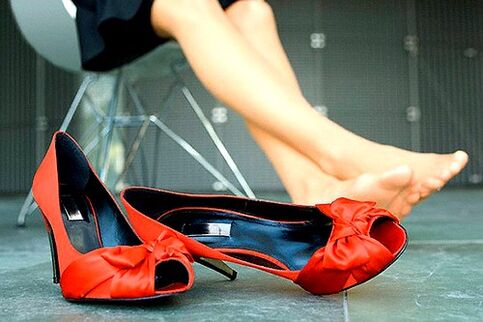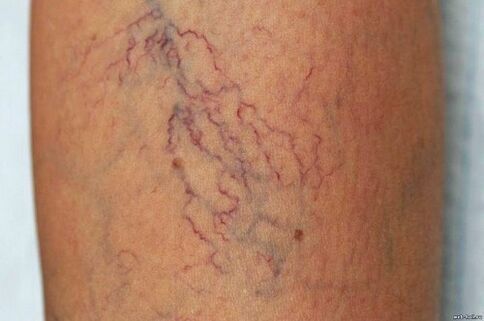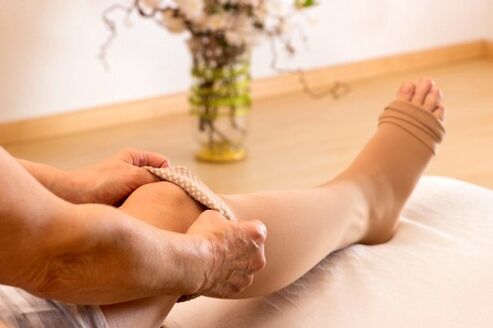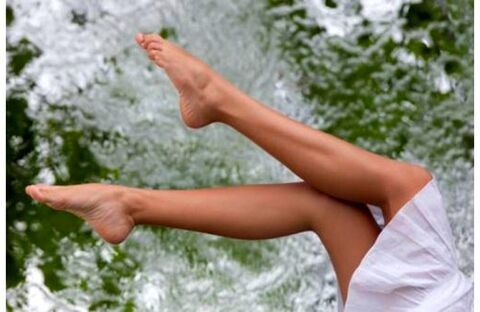Varicose veins on the legs are not only a cosmetic problem that causes people to worry about their attractiveness, but also a dangerous disease that requires compliance with adequate treatment and preventive measures.
There are many reasons for the formation of varicose veins: a sedentary lifestyle, physical overload, hormonal imbalances, congenital weakness of the vascular walls and pregnancy.What happens in varicose veins?Varicose veins of the lower extremities lose their normal elasticity and stretch under blood pressure.
The valves in the vein normally lock and close when the blood passes through and allow the blood to flow back.If there is a valve malfunction, blood can flow freely, resulting in blood stasis.
In this regard, the veins cannot cope with the pressure, they expand, the valves can no longer close the large lumen ... All this proves that the initial stage of varicose veins has occurred (see photo).
Reasons
Why do varicose veins occur and what are they?The main risk factors for the development of the disease are genetic predisposition and gender.The love of high heels, hormonal changes during pregnancy and the use of contraceptives, women are twice as likely to suffer from varicose veins as men.
The development of the disease is promoted:
- Hereditary.Miracid is not the disease itself, but a genetically determined structure of the vessels: weak connective tissue of the venous walls, congenitally defective vascular valve.Therefore, varicose veins can be observed in young, healthy and active people (regardless of gender) and even in children.According to scientists, genetic predisposition is the main factor leading to varicose veins in the legs.
- Hormonal changes.In women, periods of hormonal imbalance due to the characteristics of the body cause blood stagnation.The most dangerous periods for them are puberty, pregnancy and postpartum.Menopause is also dangerous.This gender category of patients turns to doctors 2-3 times more often.Women's bodies do not have enough hormones called estrogens.Instead, the so-called Corpus luteum hormones dominate.It is believed to have a relaxing effect on the muscles.It helps to dilate blood vessels.
- A sedentary lifestyle for a long time or work that requires work contributes to the development of varicose veins.
- Age.Over time, the valves and walls of the vessels become thinner, which causes their functions to malfunction.
- Obesity.Excess weight causes increased stress on the veins of the legs.
Secondary varicose veins occur with leg injuries, heart defects, liver and spleen dysfunction.In this case, first of all, appropriate treatment of the primary disease is carried out.
What causes varicose veins?
The main risk factors for the development of the disease are genetic predisposition and gender.The love of high heels, hormonal changes during pregnancy and the use of contraceptives, women are twice as likely to suffer from varicose veins as men.
The development of the disease is promoted:
- Obesity
- Staying in a standing or sitting position
- Heavy physical activity
- Sedentary lifestyle
- Constipation
- Alarmed
Secondary varicose veins occur with leg injuries, heart defects, liver and spleen dysfunction.In this case, first of all, appropriate treatment of the primary disease is carried out.
What causes varicose veins?
The development of varicose veins is based on the congenital weakness of the venous wall, the valves of superficial veins, resulting in an increase in venous pressure.A special one-way valve prevents the blood from flowing behind and prevents it from standing in one place;When corrected, the flow of blood from the tissues to the heart is impaired.It should be noted that conservative treatment does not affect blood pressure.
Stage
There are 3 stages of symptom progression in the development of varicose veins.
- Compensation stage.No complaints.On examination, varicose veins are observed in one or both legs.
- Subcompensation stage.After the examination, the announced varicose veins are visible on the legs.Patients complain of fullness, paresthesia ("pins and needles") in the lower legs and night cramps.In the evenings, there is a slight swelling of the legs, ankles and feet.Morning swelling disappears.
- Decompensation stage.Dermatitis and eczema are added to the listed symptoms.Patients are concerned about itchy skin.The skin is dry, shiny, densely fused with subcutaneous tissue.Small bleeding and subsequent deposition of hemosiderin causes hyperpigmentation.
Varicose veins in themselves are not considered a very serious disease, but if they already develop, they will never go away on their own, and even more so, they will cause all kinds of complications that pose the greatest danger.
Signs
The first signs that indicate the beginning of the development of varicose veins:
- Rapid leg fatigue;
- swelling of the lower extremities;
- heaviness in the legs.
In the later stages, it shows the appearance of spider veins on the skin, appearance of protruding veins and various seals, blockage in blood vessels.
Varicose veins: symptoms

It is quite difficult to diagnose the early stages of the disease, because at the initial stage, there are no spider veins and dilated veins rising above the skin.
Early symptoms of varicose veins:
- Heavy legs at the end of the day
- Fatigue
- Pain from mild pain
- The venous pattern on the skin increased
Often, the patient does not feel other symptoms of the disease, and only cosmetic defects on the skin cause concern, before they are detected in previously unseen places or veins.As a rule, in the early stages, the symptoms of varicose veins disappear completely or are significantly reduced with rest, and therefore are often ignored.
One or more varicose nodes appearing on the skin indicate the progression and indifference of the disease.When standing for a long time, painful pain is felt in the area of the joints, numbness, tingling, "creeping" and swelling in the legs.By the end of the day, the swelling often disappears after a night's sleep.Swelling can be judged by loose shoes that begin to press in the evening.
Why are varicose veins dangerous?

Thrombophlebitis is the most common complication of varicose veins.In addition, the increased pressure in the venous part causes the penetration of red blood cells through the walls of blood vessels.For this reason, skin pigmentation, thickening and tissue hypoxia, which contribute to the appearance of trophic ulcers, are observed.Even with minor damage to the skin in the node area, it can tear and cause heavy bleeding.
Diagnostics
In order to diagnose varicose veins of the lower extremities and prescribe the appropriate treatment, the specialist will ask the patient to undergo a comprehensive examination that includes various methods.
- Duplex scanning (ultrasound of the vessels) is the most informative method with a diagnosis of blood flow from vessels, vessels, veins and their patency, as well as blood clots (thrombi) and the size of the blood flow.
- Contrast venography, which is an examination method that allows you to detect the approximate veins and get information about the degree of their patency for blood.
Only a highly qualified phlebologist can diagnose deep vein varicose veins.
The result
The complicated course of varicose veins is accompanied by the formation of thrombosis and inflammation of veins, trophic ulcers and skin disorders.These complications are manifested in changes in skin color, redness, darkening and blueness of the skin.
It is also characterized by constant swelling of the ankle, especially severe when walking or standing.Pain when walking in the calf area, pain along the painful vein, thickening of the skin and the formation of ulcers of different sizes on it.
During pregnancy
Pregnancy significantly increases the risk of developing varicose veins of the lower extremities due to the following reasons:
- Hormones circulating in the blood during pregnancy increase the distance of the venous wall and contribute to stagnation of venous blood in the legs.
- At the end of pregnancy, the increase in pressure inside the abdomen makes it difficult for blood to flow through the veins.
- Varicose veins that appear during pregnancy may disappear completely after childbirth or may progress further depending on individual factors (heredity, presence of other contributing factors).
Treatment of varicose veins in the legs
For varicose veins in the legs, treatment may not be medically necessary unless the symptoms are problematic.
However, some people may want to be treated for varicose veins for cosmetic reasons because they are unhappy with their appearance.
Let's look at the main methods that will help you get rid of this problem.
- Sclerotherapy.This method of treatment is used both independently and in combination with conservative procedures.Its essence, a special drug that seals it, is injected into the vein with a thin needle or syringe, and then the vein disappears completely.Sessions are held once a week, from 3 to 6 such sessions are required.The method allows you to avoid scars and wounds.
- Non-surgical treatment.If the varicose veins are in the early stages and are not causing too much discomfort, elastic compression stockings may be recommended.They are worn during daily activities.They help to tighten the veins and keep any discomfort or pain from prolonging or limiting.
- Medicinal treatment of varicose veins relieves symptoms, reduces swelling and pain, slows down the development process, but cannot completely stop the disease and restore damaged veins.
- Laser treatment for varicose veins in the legs can be used on the surface of the skin.With the help of a small laser light, a sclerosis process develops in the vessel wall and the varicose vein disappears as if it were removed.
Physical activity plays a key role in treatment and prevention - water gymnastics, gymnastics, swimming and exercises (tennis, weightlifting, jumping).
Conservative treatment of varicose veins is prescribed mainly to people who have clear indications for surgical intervention.
Also, if the patient has small varicose veins with a slight defect, such treatment is indicated.The goal of conservative therapy is to prevent further progression of this disease.For this purpose, patients are advised to bandage the legs affected by varicose veins with an elastic bandage.In addition, compression knitting is indicated for varicose veins.People prone to varicose veins or already suffering from this disease should regularly rest their legs on this path for a few minutes and place their feet at a high level.There are also special exercises for the lower leg and foot aimed at activating the musculo-venous pump.This is the periodic extension and flexion of the ankle and knee joints.
The patient should be careful not to allow the legs and thighs to be pulled together with various toiletries, as this can significantly impede the flow of venous blood.
Using elastic compression, you can activate blood flow in deep vessels, prevent swelling, reduce the amount of blood in filtered vessels, promote metabolic processes and microcirculation of the body.
However, it is important to properly bandage the foot to get positive results.This process should be done in the morning before getting out of bed.Bataring starts from the toes to the thigh and a slight tension of the bandage should be felt.Be sure to capture the heel and ankle joint during the banding process.In each turn around the limb, the bandage should cover half of the previous turn.You should only buy certified elastic bandages and compression stockings.
Treatment of varicose veins also includes wearing comfortable shoes with low heels and hard soles.You should not stand for a long time, allow physical stress or stay in rooms with high temperature and humidity for a long time.It is advisable to keep your feet elevated while sleeping.
Patients should limit fluid and salt intake and try to get rid of it overweight.To treat varicose veins, it is necessary periodically to take diuretics, which improve the tone of the veins.In addition, if indicated, drugs that stimulate microcirculation in diseased tissues can be prescribed.Varicose veins can also be treated with nonsteroidal anti-inflammatory drugs.
If the patient has a difficult form of the disease, physical therapy exercises are indicated.Swimming, other water treatments, foot baths with warm water with 5-10% sodium chloride solution are very useful.
Local therapy methods are often used in the treatment of varicose veins.However, this type of treatment should be used in combination with other medicinal methods.Local remedies for varicose veins are produced in the form of gels, ointments and creams.Most of these drugs contain heparin or venoactive components.Ointments for varicose veins help to normalize the tone of the vessel walls and can correct lymphatic drainage and microcirculation disorders.Some topical preparations contain several different active ingredients.
If a second infection occurs during varicose veins, it is recommended to use external agents antibiotics or antiseptics.
It has been used for treatment since ancient times hirudotherapy with varicose veins.The use of plasters that hide hirudin helps to thin and resorb the blood from the blood blood clot, getting rid of spider veins and varicose veins.In addition, hirudotherapy for varicose veins can reduce pain and swelling in the legs.However, it is important to use hirudotherapy in the earliest stages of varicose veins.This treatment should not be used in humans hemophilia, anemia, hypotension, Pregnant women.
However, the radical method of treating varicose veins is surgery.Venisten is used to eliminate reflux.This operation is not performed if the patient has positive diseases of the lungs, cardiovascular system, kidneys or liver.This operation should not be performed on pregnant women, as well as people suffering from heat-related diseases.Modern technologies allow using endoscopic techniques for such an operation.
If a person only has small branches enlarged, sclerotherapy can be used.This operation injects a sclerosing solution into the vein to seal the vein walls.After that, a repeated injection is made to other parts of the vein, achieving complete emptying of the vein.
Combined surgical therapy is also used for varicose veins, large trunks of changed veins are removed and sclerotherapy of small branches is performed.After surgery, patients are advised to continue wearing an elastic bandage for 8-12 weeks.
Conservative treatment
Those looking for an effective and miraculous treatment for varicose veins will immediately be disappointed: even the most modern and expensive drugs cannot completely eliminate varicose veins.It helps to improve pain, swelling and even the condition of the venous wall, but complete recovery does not occur.

In addition, conservative treatment brings a noticeable effect only at the initial stage of the disease, after which it is carried out to prevent further development of varicose veins.The leading role in the treatment of this disease belongs to herbal medicines based on natural plant substances.But we must not forget that most poisonous drugs cause photography;When taking them, exposed skin should not be allowed to be exposed to sunlight.
With the use of drugs, relaxation measures and special exercises for the legs, doctors recommend regularly wearing compression stockings: socks, knee socks, tights.They improve blood microcirculation and prevent edema.It is very important to choose the right size of elastic stockings and the degree of compression, which can be both preventive and therapeutic.
Treatment with tablets and ointments
To improve vascular tone, venotonic tablets are used for varicose veins - phlebotonics.These drugs are analogues and contain a purified flavonoid fraction consisting of 90% diosmin.One tablet is taken twice a day, the course of treatment is selected individually.
You can reduce capillary permeability, reduce blood viscosity and increase the tone of blood vessels with the help of preparations based on horse chestnut.
How to treat varicose veins with folk remedies
There are many methods for the treatment of varicose veins in the legs with folk remedies for both external and internal use.Below are the most common:
- Horse chestnut flowers (50 grams) should be poured with 500 grams of alcohol, then allowed to brew for 14 days, shaking the bottle every day.Pass the tincture through a mesh and take one spoon with water three times a day before meals.After one week of treatment, take a break for two weeks.Then the treatment can be started again.
- An infusion of dried nettle is used for varicose veins.Dry crushed leaves of the plant are poured into a thermos with 1/2 liter of boiling water, left for 30-40 minutes, filtered and taken 1/3 cup after 1 hour a day.
- Tomato compress.Finely chopped tomatoes, a bandage, jazz and applied to the wound point.For convenience, you can tie it with an elastic or other bandage.Keep this compress in the vein for 2 hours, then change to a new one and 3 times in total.The convenience of this compress is that it can be repeated every day.
- Tincture of walnut oil tincture: chop the labeled nuts, pour into a glass container, pour olive oil and leave in a sunny place for 40 days.Lubricate the wound areas with the prepared tincture.The course of treatment is related to the use of Kalanchoe.
In addition to folk remedies, many patients with varicose veins, additional therapy with special gymnastics - Mikulin exercises allow to feel a significant improvement.
Aggravation of varicose veins of the legs
Very often, it appears as a complication of varicose veinsAcute thrombophlebitis of superficial veins.Sometimes, as a result of damage, varicose veins rupture and bleed.When blood leaks from a burst node, significant blood loss is possible.
In addition, arterial blood flow slows down due to pressure in the venous system.That's why it can develophypoxiaand beyondoxygen starvation.As a result of the development of these conditions, tissue cells can become country, which is a dangerous process for the body.Due to the severe stagnation of blood in the veins, toxins accumulate in the tissues.
Complications of this disease include blood clots in the blood vessels, nutrition of the tissues of the leg, and blockage of the blood vessels with pigmentation and darkening of the skin.
The cafsutan fat layer gradually becomes denser anddermatitis,venous troz ulcers.Very rarely, such ulcers degenerate into a malignant joint.
If the disease persists for a long time, the person may develop laterchronic venous insufficiency.
But it is the most dangerous complication of varicose veinslung.This disease can be fatal.
Preventive measures

If you belong to a risk group, your relatives suffer from varicose veins or are forced to spend a lot of time due to their occupation, you should pay special attention to the condition of your legs so that the first "calls" do not miss.
Basic preventive measures prevent the onset of the disease and slow down the progression of existing varicose veins.
Preventive measures:
- Avoid excessive exposure to sunlight and hot baths.Ideally, baths and saunas should not be visited at all.
- Avoid wearing tight shoes, tight socks, and tight-fitting clothing.
- The optimal heel height is no more than 6 cm.
- Avoid weight gain.Try to eat a diet rich in fiber, vegetables and fruits.
- Avoid excessive physical activity and heavy lifting.
- Special exercises for your legs, including lifting them ("bicycle", "scissors").
- Massage yourself when there are no swollen veins.
- At the end of the day, wash your feet in cool water;A contrast shower also has a positive effect.
Despite their prevalence, varicose veins are quite difficult to treat.When the first alarming symptoms appear, do not delay your visit to a vascular surgeon, because the sooner the disease is detected, the more chances to avoid surgery.
To predict
Varicose veins in the legs are a disease that can be treated for years;Even after surgical removal, 80% of them reappear.
The prognosis depends on the stage at which treatment is started.In the early stages, a set of preventive measures (treatment of varicose veins with venotonics twice a year and a healthy lifestyle) allows to stop the further development of the disease.You must adhere to a strict framework of prevention throughout your life.
In the later stages (those with severe deformation, swelling, swelling, and tissue oxygen starvation), elective diseases (diabetes, obesity) and the patient's willingness to follow the doctor's recommendations (research, take medication, lose weight) are determined.
Complications of diabetes mellitus, varicose veins (thrombophlebitis, trophic ulcers) develop in 89%.
Varicose veins are considered a non-life-threatening disease, but its complications can greatly impair quality of life and prognosis.About 50% of patients with deep vein thrombosis die from thromboembolism within 3 months.


















